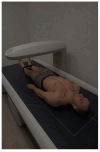The Influence of Step Load Periodisation Based on Time Under Tension in Hypoxic Conditions on Hormone Concentrations and Postoperative ACL Rehabilitation of a Judo Athlete: A Case Study
- PMID: 40283380
- PMCID: PMC12027879
- DOI: 10.3390/jcm14082549
The Influence of Step Load Periodisation Based on Time Under Tension in Hypoxic Conditions on Hormone Concentrations and Postoperative ACL Rehabilitation of a Judo Athlete: A Case Study
Abstract
The aim of this study was to determine the effect of a step load periodisation protocol for the rehabilitation of the anterior cruciate ligament (ACL) based on the variables of both the tempo of movement and time under tension (TUT) in normobaric hypoxia using a case study. Introduction: We verified the influence of variables such as time under tension (TUT) and the tempo of movement in hypoxia on the concentration of insulin-like growth factor 1 (IGF-1), growth hormone (GH), and erythropoietin (EPO). The effectiveness of the protocol also concerned variables such as peak torque of the knee flexors and extensors and maximum oxygen uptake (VO2max), as well as body composition analysis. Methods: The study used a 28-year-old judoka athlete from the national team, competing in the weight category up to 73 kg. Results: The use of short partial rest breaks between series (80s) in combination with six exercises in four series and a hypoxic environment (FiO2 = 15%) significantly increased metabolic stress, resulting in the highest increase in GH and IGF in the main phase of accumulation of the 3:1 step load. During 16 running sessions, the rehabilitated athlete achieved a significant increase in individual variables in the running test. Conclusions: The combination of a hypoxic environment combined with a periodized rehabilitation protocol can induce a number of positive hormonal, circulatory and respiratory reactions as well as positively influence muscle asymmetry, which can ultimately shorten the time it takes for an athlete to return to sport (RTS).
Keywords: ACL rehabilitation; VO2 max; erythropoietin; growth hormone; hypoxia; insulin-like growth factor 1; isokinetic; periodisation; step load; tempo; time under tension.
Conflict of interest statement
The authors have no conflicts of interest to declare.
Figures
Similar articles
-
Effect of Step Load Based on Time under Tension in Hypoxia on the ACL Pre-Operative Rehabilitation and Hormone Levels: A Case Study.J Clin Med. 2024 May 9;13(10):2792. doi: 10.3390/jcm13102792. J Clin Med. 2024. PMID: 38792333 Free PMC article.
-
Use of blood flow restriction for increasing the strength of the ischiocrural muscles in anterior cruciate ligament rehabilitation: A case report.Physiother Res Int. 2024 Jan;29(1):e2059. doi: 10.1002/pri.2059. Epub 2023 Nov 14. Physiother Res Int. 2024. PMID: 37964694
-
Gait patterns differ between ACL-reconstructed athletes who pass return-to-sport criteria and those who fail.Am J Sports Med. 2013 Jun;41(6):1310-8. doi: 10.1177/0363546513482718. Epub 2013 Apr 5. Am J Sports Med. 2013. PMID: 23562809 Free PMC article.
-
Optimising the Late-Stage Rehabilitation and Return-to-Sport Training and Testing Process After ACL Reconstruction.Sports Med. 2019 Jul;49(7):1043-1058. doi: 10.1007/s40279-019-01102-z. Sports Med. 2019. PMID: 31004279 Review.
-
ACL reconstruction in the professional or elite athlete: state of the art.J ISAKOS. 2021 Jul;6(4):226-236. doi: 10.1136/jisakos-2020-000456. Epub 2021 Feb 16. J ISAKOS. 2021. PMID: 34272299 Review.
References
-
- Prados-Barbero F.J., Sánchez-Romero E.A., Cuenca-Zaldívar J.N., Selva-Sarzo F. Differences in Movement Patterns Related to Anterior Cruciate Ligament Injury Risk in Elite Judokas According to Sex: A Cross-Sectional Clinical Approach Study. Electron. J. Gen. Med. 2024;21:em574. doi: 10.29333/ejgm/14285. - DOI
Publication types
LinkOut - more resources
Full Text Sources
Research Materials
Miscellaneous





